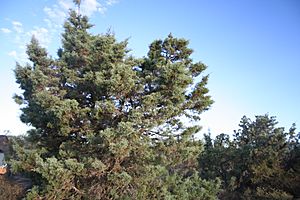Actinostrobus facts for kids
Quick facts for kids Actinostrobus |
|
|---|---|
 |
|
| Actinostrobus arenarius | |
| Scientific classification |
|
| Kingdom: | Plantae |
| Clade: | Tracheophytes |
| Division: | Pinophyta |
| Class: | Pinopsida |
| Order: | Pinales |
| Family: | Cupressaceae |
| Subfamily: | Callitroideae |
| Genus: | Actinostrobus Miq. |
| Species | |
|
See text |
|
Actinostrobus is a small group of conifer trees and shrubs. They are part of the cypress family (Cupressaceae). People often call them cypress, sandplain-cypress, or cypress-pine. The name "cypress-pine" is also used for a similar group of plants called Callitris.
Meet the Species
There are three types of Actinostrobus plants. All of them grow only in the southwestern part of Western Australia. When a plant grows only in one specific area, it is called endemic.
| Image | Name | Common Name | Where it Grows |
|---|---|---|---|
| Actinostrobus arenarius | Sandplain-cypress | Western Australia | |
| Actinostrobus pyramidalis | Swan River cypress, Swamp cypress, Western Australian swamp cypress, King George's cypress pine | Southwestern Western Australia | |
| Actinostrobus acuminatus | Dwarf cypress, Creeping pine, Moore cypress pine | Southwestern Western Australia |
What They Look Like
Actinostrobus plants are usually shrubs or small trees. They can grow to be about 3 to 8 meters (10 to 26 feet) tall.
Their leaves stay green all year round, which means they are evergreen. They have two main types of leaves:
- Young leaves: These are like needles, about 10 to 20 millimeters (0.4 to 0.8 inches) long. You mostly see them on young plants.
- Adult leaves: These are smaller, like scales, about 2 to 8 millimeters (0.08 to 0.3 inches) long. They cover the twigs.
The leaves are arranged in neat rows along the branches.
Cones and Seeds
Actinostrobus plants produce two kinds of cones:
- Male cones: These are small, only about 3 to 6 millimeters (0.1 to 0.2 inches) long. They grow at the very tips of the branches.
- Female cones: These start out small too. They take about 18 to 20 months to grow fully. When they are ready, they are about 10 to 20 millimeters (0.4 to 0.8 inches) long and wide. They are round or egg-shaped and have six thick, woody scales.
These female cones stay closed on the tree for many years. They only open up after a bushfire has scorched them. This special way of opening helps release the seeds onto the ground that has just been cleared by the fire. This allows new plants to grow in the freshly burnt soil.
Family Ties
The closest plant relatives to Actinostrobus are the Callitris trees. Callitris plants are found in many more places across Australia. The main difference between them is that Callitris cones do not have the small, extra scales at their base that Actinostrobus cones do.
Uses and Risks
The wood from Actinostrobus is light, soft, and smells nice. However, these plants are usually too small to be used for much. Sometimes, people plant them in gardens as ornamental shrubs. But it's important to know that they can catch fire very easily during bushfires, which makes them risky to plant in some areas.
See also
 In Spanish: Actinostrobus para niños
In Spanish: Actinostrobus para niños



